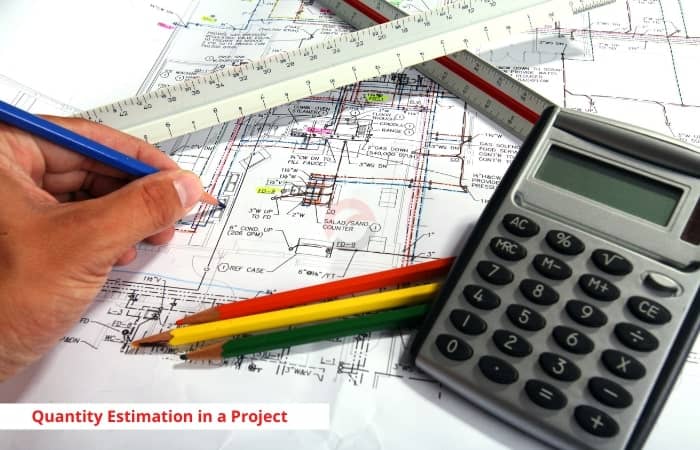Importance of quantity estimation in a project
Estimating quantity of different material in a construction project helps in to give the stakeholder of the project an idea of the quantity required for different material in the project which indeed makes it easy to plan for the same so that the project cost can be estimated perfectly and arrangement for the fund can be made in advance. This leads to a smooth flow during the execution of the project and the project can be completed within stipulated

Sequence to calculate cement, sand, and aggregate quantity are: (To calculate the quantity we need to have the volume and the grade of the concrete structure of which we want the quantity)
- Calculate the dry volume out of wet volume of the concrete then,
- Calculate the cement quantity then,
- Calculate the sand quantity then,
- Calculate the aggregate
Before starting assume that we have to calculate the quantity for cement, sand, and aggregate for a volume of 1m3
As specified in the question the grade of the concrete is M15 so the mix ratio of the constituent material will be: 1: 2: 4 (cement: sand: aggregates) {Grades of concrete are defined as the concrete mix proportion of cement, sand and aggregates also it defines the minimum strength of concrete at end of 28 days curing}.
In a grade M stands for Mix and the number after it gives the compressive strength of concrete at 28 days in N/mm2
- Total part present in the ratio comes out to be, 1+2+4 = 7
- So, Part of the cement in Mix is 1/7. Part of the sand is in Mix 2/7.
Part of aggregates is in Mix 4/7.
Also Read: Volume of Hollow Cylinder
Step 1: Calculating the dry volume out of wet volume of the concrete
The wet volume of the concrete is 1m3 to convert it into dry volume we need to multiply it with 1.54 (1.54 is the conversion factor of wet volume to dry volume of concrete i.e., Dry volume = Wet volume + 54 % of Wet volume)

That comes out to be, 1*1.54 = 1.54 m³
Step 2: Calculating the cement quantity
- 𝑉𝑜𝑙𝑢𝑚𝑒 𝑜𝑓 𝑐𝑜𝑛𝑐𝑟𝑒𝑡𝑒 = 𝑃𝑎𝑟𝑡 𝑜𝑓 𝑐𝑒𝑚𝑒𝑛𝑡 𝑖𝑛 𝑀𝑖𝑥 ∗ 𝐷𝑟𝑦 𝑣𝑜𝑙𝑢𝑚𝑒 𝑜𝑓 𝑐𝑜𝑛𝑐𝑟𝑒𝑡𝑒
- 𝑉𝑜𝑙𝑢𝑚𝑒 𝑜𝑓 𝑐𝑜𝑛𝑐𝑟𝑒𝑡𝑒 = 1/7 ∗ 1.54 𝑚3
- 𝑉𝑜𝑙𝑢𝑚𝑒 𝑜𝑓 𝑐𝑜𝑛𝑐𝑟𝑒𝑡𝑒 = 0.22 𝑚3
There are two ways to convert the volume of cement into the number of bags required. First, is to use the volume of 50kg cement bag and divide it with the volume of cement another one is to multiplying the density of the cement with volume to get the weight and then dividing it by 50 to get the exact no. of bag required.
Here, using first-way volume of 1 Bag of cement (50 kg) is 0.0347.
So, the total number of Bag required is 0.22/0.0347 = 6.34 Approximately 7 Bag of cement is required (Volume of concrete/ Volume of 1 Bag of cement).
Step 3: Calculating the sand quantity
- 𝑉𝑜𝑙𝑢𝑚𝑒 𝑜𝑓 𝑠𝑎𝑛𝑑 = 𝑃𝑎𝑟𝑡 𝑜𝑓 𝑠𝑎𝑛𝑑 𝑖𝑛 𝑀𝑖𝑥 ∗ 𝐷𝑟𝑦 𝑣𝑜𝑙𝑢𝑚𝑒 𝑜𝑓 𝑐𝑜𝑛𝑐𝑟𝑒𝑡𝑒
- 𝑉𝑜𝑙𝑢𝑚𝑒 𝑜𝑓 𝑠𝑎𝑛𝑑 = 2/7 ∗ 1.54 𝑚3
- 𝑉𝑜𝑙𝑢𝑚𝑒 𝑜𝑓 𝑠𝑎𝑛𝑑 = 0.44 𝑚3
To convert the volume of sand to weight we will use a formula of density which is d=W/V (where d represents density, W represents weight, and V represents volume).
So, 𝑊 = 𝑉 ∗ 𝑑
𝑊𝑒𝑖𝑔ℎ𝑡 𝑜𝑓 𝑠𝑎𝑛𝑑 = 0.44 ∗ 1740 kg (Density of sand = 1740)
So, the Weight of the sand required is 765.6 kg Approximately 766 kg of sand.
Step 4: Calculating the aggregate quantity
- 𝑉𝑜𝑙𝑢𝑚𝑒 𝑜𝑓 𝑎𝑔𝑔𝑟𝑒𝑔𝑎𝑡𝑒 = 𝑃𝑎𝑟𝑡 𝑜𝑓 𝑎𝑔𝑔𝑟𝑒𝑔𝑎𝑡𝑒 𝑖𝑛 𝑀𝑖𝑥 ∗ 𝐷𝑟𝑦 𝑣𝑜𝑙𝑢𝑚𝑒 𝑜𝑓 𝑐𝑜𝑛𝑐𝑟𝑒𝑡𝑒
- 𝑉𝑜𝑙𝑢𝑚𝑒 𝑜𝑓 𝑎𝑔𝑔𝑟𝑒𝑔𝑎𝑡𝑒 = 4/7 ∗ 1.54 𝑚3
- 𝑉𝑜𝑙𝑢𝑚𝑒 𝑜𝑓 𝑎𝑔𝑔𝑟𝑒𝑔𝑎𝑡𝑒 = 0.88 𝑚3
- 𝑊𝑒𝑖𝑔ℎ𝑡 𝑜𝑓 𝑎𝑔𝑔𝑟𝑒𝑔𝑎𝑡𝑒 = 0.88 ∗ 1550 kg (Density of aggregate = 1550)
So, the Weight of the sand required is 1364 kg of aggregate.
Also Read: How many yards in a ton of Gravel, Sand, Cement, Rock, Asphalt, Mulch and Limestone
Still a question, please ask a question and get an instant answer from subject matter experts.


Leave a comment